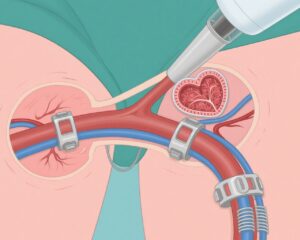Highlight
The Adolescent and Young Adult Healthcare Transition (AYA HCT) clinic effectively maintains retention in HIV care at one year (100%) among transitioning youth. Despite high engagement, viral suppression rates remain suboptimal at 79.3%, improving to 96.8% post-transition to adult care. Key strengths include Ryan White funding and program adaptability; major challenges include HIV-related stigma and adverse social determinants in the Southeastern US region.
Study Background and Disease Burden
Adolescents and young adults (AYAs) living with HIV face unique challenges during the transition from pediatric to adult care services. This period is critical, as retention rates often decline and viral suppression remains difficult to achieve, contributing to poor long-term health outcomes and increased risk of HIV transmission. Structural barriers, stigma, and social determinants of health complicate successful healthcare transitions. Innovative care models tailored to this population are urgently needed to improve outcomes and support sustained viral suppression.
Study Design
This study employed a mixed-methods approach within the Adolescent and Young Adult Health Clinic based in the Southeastern United States. The clinic model—referred to as the AYAHCT clinic—aimed to directly address challenges faced in the pediatric-to-adult HIV care transition.
Quantitative Analysis: The medical records of 18 AYAs (mean age at first visit 19.8 years, 78% male) transitioning to adult care were retrospectively reviewed for clinical outcomes, including number of clinic visits per year, retention in care at 1 year, and viral suppression (measured by HIV viral load).
Qualitative Analysis: Nine semistructured interviews were conducted with key stakeholders—providers and staff involved in pediatric, AYAHCT, and adult HIV clinics—to elucidate the facilitators and barriers affecting clinic implementation.
Key Findings
Patients attending the AYAHCT clinic averaged 4.4 visits annually and achieved exceptional retention in care at 100% after 1 year. Despite this, viral suppression at this stage was achieved in 79.3% of patients, indicating room for improvement.
Among the seven patients who transitioned fully to adult care services, retention remained high at 85.7%, and viral suppression rates improved markedly to 96.8%. These data suggest sustained engagement post-transition enhances virologic control.
Key facilitators identified through qualitative interviews included:
– Ryan White funding, which provided critical financial resources enabling program sustainability.
– Strong community connections fostering trust and support among AYAs.
– Positive attitudes and commitment of healthcare providers and staff.
– Flexibility and adaptability of the program to respond to patient needs.
Barriers highlighted were:
– Persistent HIV-related stigma adversely affecting patient engagement and disclosure.
– The local political climate, which may limit service availability or support.
– Operational challenges in clinic workflows, occasionally hindering seamless care delivery.
– Social determinants such as housing instability, transportation issues, and socioeconomic hardships.
Expert Commentary
This study illustrates that tailored care models like the AYAHCT clinic can substantially improve retention for young people living with HIV—a crucial step toward optimizing health outcomes. The findings underscore the complexity of viral suppression challenges despite retention, suggesting that comprehensive interventions beyond clinic attendance are needed, such as psychosocial supports and stigma reduction efforts.
The mixed-methods design enriches understanding by integrating patients’ clinical results with stakeholder perspectives, thereby informing scalable programmatic strategies. However, the modest sample size and single-center design may limit generalizability.
Future research should focus on longitudinal assessment with larger cohorts and explore interventions specifically designed to overcome persistent structural and social barriers to viral suppression.
Conclusion
The AYAHCT clinic represents an innovative approach to bridging pediatric and adult HIV care for adolescents and young adults. By leveraging funding mechanisms and community resources, it achieves remarkable retention outcomes. However, viral suppression remains a challenge, indicating a need for intensified efforts addressing stigma, social determinants, and tailored adherence support. This model provides a promising framework for enhancing HIV care transitions and offers important insights for health systems aiming to support this vulnerable population effectively.
References
Hill NE, Pierce L, Chew H, Sellers A, Schlundt D, Desai N, Ahonkhai AA. Evaluating patient outcomes and stakeholder perspectives in a novel healthcare transition clinic for young people living with HIV: a mixed methods study. AIDS Care. 2025 Jul 21:1-14. doi: 10.1080/09540121.2025.2534124. Epub ahead of print. PMID: 40691868.



